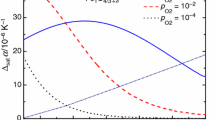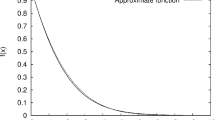Abstract
The equations for heat capacity measured under isodynamical conditions (fixed activity of a single component) are derived for partly open systems exchanging one component with the surroundings while keeping the contents of all other components constant. Compared to conventional isobaric (and isoplethal) heat capacity of a strictly stoichiometric phase, the isodynamical heat capacity of a nonstoichiometric phase is found to involve two additional terms—the saturation contribution due to incorporation (or release) of the free component and the contribution due to deviation from stoichiometry reflecting a different number of the involved phonon modes (due to different free component content) and in some cases a variation of free component incorporation mechanism.



Similar content being viewed by others
References
Maxwell JC. Theory of heat. London: Longmans, Green, and Co; 1871.
Holba P. Thermodynamics of partially open systems. Czech J. Phys. 1992;B42(6):549–575.
Holba P. New thermodynamic potentials and clapeyron equations for condensed partly open systems. In: Šesták J, Holeček M, Málek J, editors. Some thermodynamic, structural and behavioral aspects of solids accentuating amorphous materials. Pilsen: Westbohemian University; 2009. p. 98–116.
Holba P, Sedmidubský D. Crystal defects and nonstoichiometry contributions to heat capacity of solids. In: Šesták J, Šimon P, editors. Thermal analysis of micro-, nano- and non-crystalline materials. Rueil-Malmaison: Springer; 2013. p. 53–74.
Gilbert GT. Positive definite matrices and Sylvester’s criterion. Am Math Mon. 1991;98(1):44–46.
Clairaut AC. Theorie de la Figure de la Terre: tire des principes de l’hydrostatique. Paris: Durand; 1743.
Shepherd JP, Koenitzer JW, Aragón R, Spałek J, Honig JM. Heat capacity and entropy of nonstoichiometric magnetite Fe3(1-δ)O4. Phys Rev B. 1991;43(10):8461–71.
Gronvold F, Sveen A. Heat capacity and Thermodynamic Properties of Synthetic Magnetite (Fe3O4) from 300 to 1050 K. Ferrimahnetic transition and zero-point entropy. J Chem Thermodyn. 1974;6:859–72.
Darken LS, Gurry RW. The system iron-oxygen. II. Equilibrium and thermodynamics of liquid oxide and other phases. J Am Chem Soc. 1946;68:798–816.
Spencer JC, Kubaschewski O. A thermodynamic assesment of the iron-oxygen system. CALPHAD. 1978;2(2):147–67.
Philips B, Muan A. Stability relations of iron oxides: phase equilibria in the system Fe3O4–Fe2O3 at oxygen pressures up to 45 atmospheres. J Phys Chem. 1960;64:1451–1453.
Crouch AG, Hay KA, Pascoe RT. Magnetite–haematite–liquid equilibrium conditions at oxygen pressures up to 53 bar. Nat Phys Sci. 1971;234:132–133.
Iwatsuki M, Fukasawa T. Nondestructive and complete analysis of magnetite-maghemite solid solutions by a combined X-ray diffraction/ fluorescence method. Anal Sci. 1993;9:95–8.
Togawa T, Wada Y, Yoshida T, Tsuji M, Tamaura Y. Kinetic study for the formation of the oxygen deficient magnetite. MRS Proc 1994;51:344–51.
Flood H, Hill DG. The redox equilibrium in iron oxide spinels and related systems. Z Elektrochem. 1957;61(1):18–24.
Cox ED, Wagman DD, Medvedev VA, editors. CODATA key values for thermodynamics. New York: Hemisphere; 1989.
Gordeev IV. On the regularity for dissociation of ferrites with spinel structure. Inorg Mater. 1966;28:241–6.
Acknowledgements
One of the authors, P. Holba, acknowledges a support of the CENTEM project, reg. no. CZ.1.05/2.1.00/03.0088, that is co-funded from the ERDF within the OP RDI program of the Ministry of Education, Youth and Sports.
Author information
Authors and Affiliations
Corresponding author
Rights and permissions
About this article
Cite this article
Holba, P., Sedmidubský, D. Heat capacity equations for nonstoichiometric solids. J Therm Anal Calorim 113, 239–245 (2013). https://doi.org/10.1007/s10973-012-2886-1
Received:
Accepted:
Published:
Issue Date:
DOI: https://doi.org/10.1007/s10973-012-2886-1




